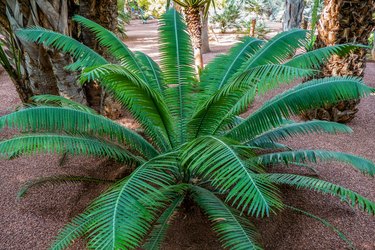
Sago palms (Cycas revoluta) are ancient plants, known as cycads, that have existed for over 200 million years. Though they don't belong to the same botanical genus as palm trees, sago palms are so named for their attractive, frond-like foliage. Sago palms grow best in climates with mild winters as they are not palm trees that can survive cold weather.
This species grows outdoors in U.S. Department of Agriculture plant hardiness zones 8 through 11. In these zones, a slight change in cultivation practices is all it takes to help your sago palm survive the winter. Outside of these zones, sago palms may be overwintered indoors. This plant is extremely toxic to humans and pets when ingested. Consumers have reported problems. No warning labels are provided by many mass merchandisers.
Video of the Day
Video of the Day
Sago Palm Temperature Tolerence
In their ideal hardiness zones, sago palms survive cool winter temperatures with very little difficulty. However, sago palm cold hardiness is not sufficient to tolerate freeze, notes the University of Florida Extension. If your area is experiencing unusually cold weather, you should prevent your sago palm from sustaining damage. Frond damage can occur when temperatures drop below 30 degrees Fahrenheit.
Wrap the plant in an overwintering blanket to protect its fronds; remove the blanket when temperatures rise. The roots of your sago palm should also be protected; spread a 6-inch layer of organic mulch on the surface of the soil around the plant to help protect and insulate the roots, advises Mississippi State University. This mulch you may leave in place indefinitely; it helps the soil conserve moisture, inhibits the growth of weeds and enriches the soil with nutrients as it decomposes.
Sago Palm Irrigation
During the spring and summer, while sago palms are in their active growth phase, the plants perform best when provided with approximately 1 inch of moisture per week. In the fall and winter, when cooler temperatures induce dormancy, the irrigation frequency and amount should lessen significantly.
Provide sago palms with no more than a 1/2 inch of water every 2 to 3 weeks. Allow the top 1 to 2 inches of soil to dry to the touch between each irrigation to avoid overwatering. Resume your regular irrigation schedule in the spring.
Sago Palm Fertilization
Sago palms have very low fertilization requirements, even while actively growing. In the fall and winter, cease fertilization entirely. Fertilizing your sago palm during its dormant phase can break dormancy and stimulate new growth that is quickly damaged by unsuitably cold temperatures. Fertilize sago palms with a single application of a specially-formulated palm tree fertilizer in the early spring to jump-start healthy growth and root formation.
Sago Palm Container Plants
Outside of their ideal hardiness zones, sago palms may be successfully cultivated as container plants. When temperatures drop below 50 degrees Fahrenheit, bring your potted sago palm indoors and position it near a window that receives at least three hours of direct sunlight and bright, indirect light for the rest of the day.
Run a cool-mist humidifier in the room where the plant is kept, but water it only once or twice a month, whenever the top 2 inches of soil feel dry. Return your sago palm to its outdoor location in the spring, after the threat of frost has passed.